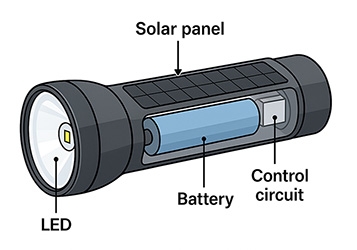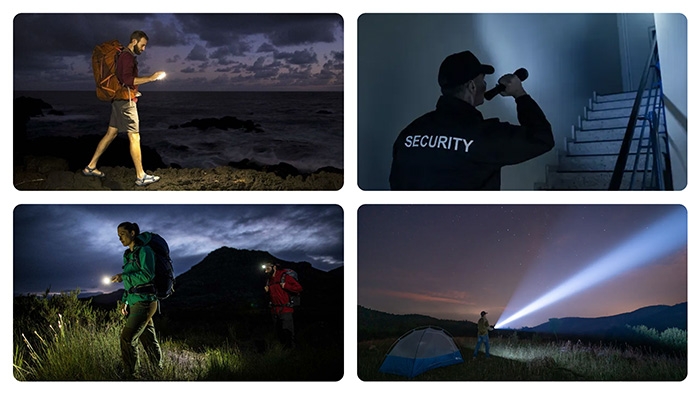As the demand for renewable energy continues to grow, the solar flashlight—a green, portable, and environmentally friendly lighting solution—is becoming an increasingly common part of everyday life. From outdoor adventures and emergency preparedness to home use and off-grid lighting in remote regions, the solar-powered flashlight is finding widespread adoption due to its unique advantages. This blog, published by Inverter.com, explores the diverse real-life applications of solar energy flashlights.
Basic Structure and Working Principle of Solar Flashlights

A typical solar flashlight consists of the following core components:
- Solar panel (photovoltaic module): Captures sunlight and converts it into electrical energy.
- Battery pack: Stores the converted solar energy, typically using lithium-ion or NiMH batteries.
- LED lighting unit: Provides high-lumen, low-energy lighting output.
- Control circuit: Regulates charging and discharging, protects the battery, and ensures safety.
This design allows the flashlight to charge during the day and illuminate at night, functioning completely off-grid without the need for external power—a highly sustainable model.
Real-Life Use Cases for Solar Flashlights
- Ideal Lighting Tool for Outdoor Activities: During activities such as camping, hiking, climbing, and fishing, traditional flashlights depend on disposable batteries or mains charging—both of which can fail in prolonged outdoor use. A solar-powered flashlight recharges during daylight hours using sunlight, offering high autonomy. For extended trips, pairing with a portable solar panel enables near-infinite runtime. Many models also feature water resistance, impact resistance, and rugged designs, ensuring reliable performance in extreme environments and making them the go-to outdoor lighting device.
- Emergency Lighting for Homes: Power outages due to natural disasters or infrastructure failure are frequent. A solar-powered torch can provide a stable light source without relying on the grid, making it a must-have emergency lighting tool for every household. Simply charge it on a balcony or windowsill during the day, and it’s ready for use at night. Advanced models may feature warning lights and SOS flash modes. Inverter's 10-in-1 emergency solar flashlight also comes with a safety hammer, which is suitable for emergency communication or sending distress signals, greatly improving the functionality of emergency use.
- Disaster Relief and Humanitarian Aid: In the wake of earthquakes, floods, or hurricanes, power systems are often the first to collapse. Traditional lighting devices become unusable without electricity, whereas solar-powered torches continue to function independently. These devices are widely distributed during humanitarian missions to provide basic lighting solutions in remote or affected areas like mountains, refugee camps, and islands. This independence from power grids makes them vital tools in humanitarian logistics and disaster recovery operations.
- Lighting Solution for Remote and Off-Grid Areas: In many developing regions and rural villages, access to electricity remains limited or nonexistent. Residents often rely on kerosene lamps or candles, which are hazardous and cause indoor pollution. Solar flashlights provide clean, bright, and sustainable off-grid lighting, improving quality of life and extending productive hours—especially for children needing light to study at night.
They also reduce dependence on fossil fuels and eliminate recurring fuel costs, offering long-term economic and health benefits. - Nighttime Use in Transport and Work Environments: Some solar-powered torches are designed to be hung on backpacks, bicycles (such as solar flashlights with bicycle headlights and horns, designed for cycling), tents, or clothing, and are equipped with flashing functions. Many include blinking modes for enhanced visibility, ideal for nighttime cyclists, road workers, and security staff. Certain models incorporate magnetic bases, allowing them to attach to metal surfaces like car hoods for use during roadside repairs or nighttime construction work—making them highly versatile in professional and industrial settings.

Key Advantages of Solar Flashlights
Solar flashlights stand out among many lighting devices. Their advantages are not only reflected in their ease of use, but also in terms of economy, environmental protection, applicability, and other aspects.
- Environmentally Friendly and Renewable: Solar energy flashlights use an infinite, clean energy source: sunlight. They require no disposable batteries or electricity from nonrenewable sources. This eco-friendly energy model contributes significantly to reducing carbon emissions and environmental impact, especially in scenarios involving regular or long-term use.
- Economical and Cost-Saving: Although the initial purchase price of a solar torch may be slightly higher than that of a conventional flashlight, its operating cost is virtually zero. There’s no need to replace batteries or pay electricity bills. Over time, this translates into substantial savings, especially for users who need frequent portable lighting, such as farmers, outdoor workers, and nomadic communities.
- Portable and Easy to Carry: Most solar-powered torches feature compact and lightweight designs, making them easy to carry, store, or hang on backpacks for direct sunlight exposure. They come in various forms, including handheld, headlamp-style, keychain models, and lantern-style variants, giving users the flexibility to choose a style that suits their specific needs.
- Multi-Functional Capabilities: Many solar flashlights go beyond simple lighting. They often include USB output ports for charging other devices, multiple brightness settings, battery indicators, or emergency signaling (like SOS mode). These added functionalities turn the flashlight into a multi-purpose emergency tool, ideal for outdoor adventures or inclusion in survival kits.
Usage and Maintenance Tips
Proper use and care are essential for maximizing the lifespan and performance of your solar flashlight. Here are some key tips:
- Charge Smart, Use Efficiently: For optimal charging, place the solar panel torch under direct sunlight between 10:00 AM and 3:00 PM on sunny days when solar irradiance is highest. Avoid charging through window glass, which reduces solar conversion efficiency. Adjust the angle of the solar panel regularly to ensure perpendicular exposure to sunlight.
- Clean regularly, Maintain Performance: Dust and fingerprints can degrade solar panel performance. Use a slightly damp cloth to gently clean the solar panel once a month. If the solar-powered torch is unused for a long period, conduct a full charge-discharge cycle occasionally to maintain battery activity. For waterproof models, regularly inspect seals to prevent moisture damage to internal circuits.
- Use Safely, Avoid Hazards: Avoid placing the flashlight on surfaces exceeding 60°C (like a car dashboard), as overheating can damage the battery or cause safety risks. For use in educational settings or with children, select models that are eye-safe, easy to operate, and appropriately bright to avoid glare or misuse.
Conclusion
From a simple lighting tool to a smart, solar-powered multi-function device, the solar-powered flashlight represents a convergence of clean energy, convenience, and sustainability. It addresses not only everyday illumination needs but also contributes to reducing carbon footprints and promoting energy equity.
In a world increasingly focused on sustainability, the solar energy flashlight has proven itself a reliable companion—whether stored in a city home’s emergency drawer or clipped to a backpack in the wilderness. Truly, it is a beacon of green light for the modern age.
